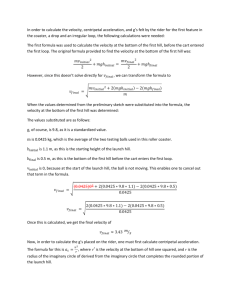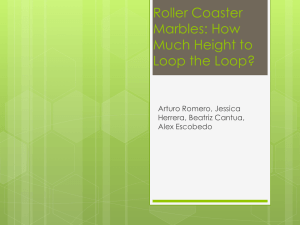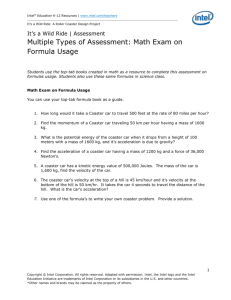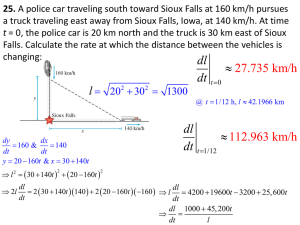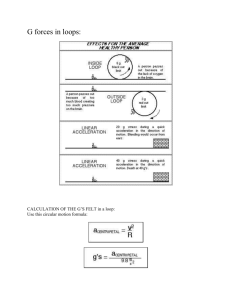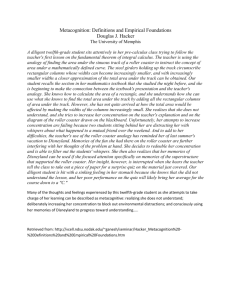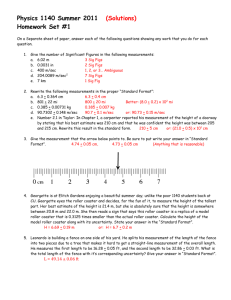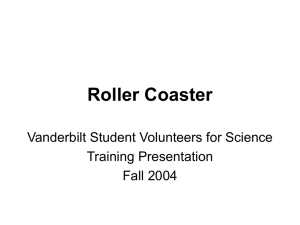Coaster Concepts and Calculations Guide
advertisement
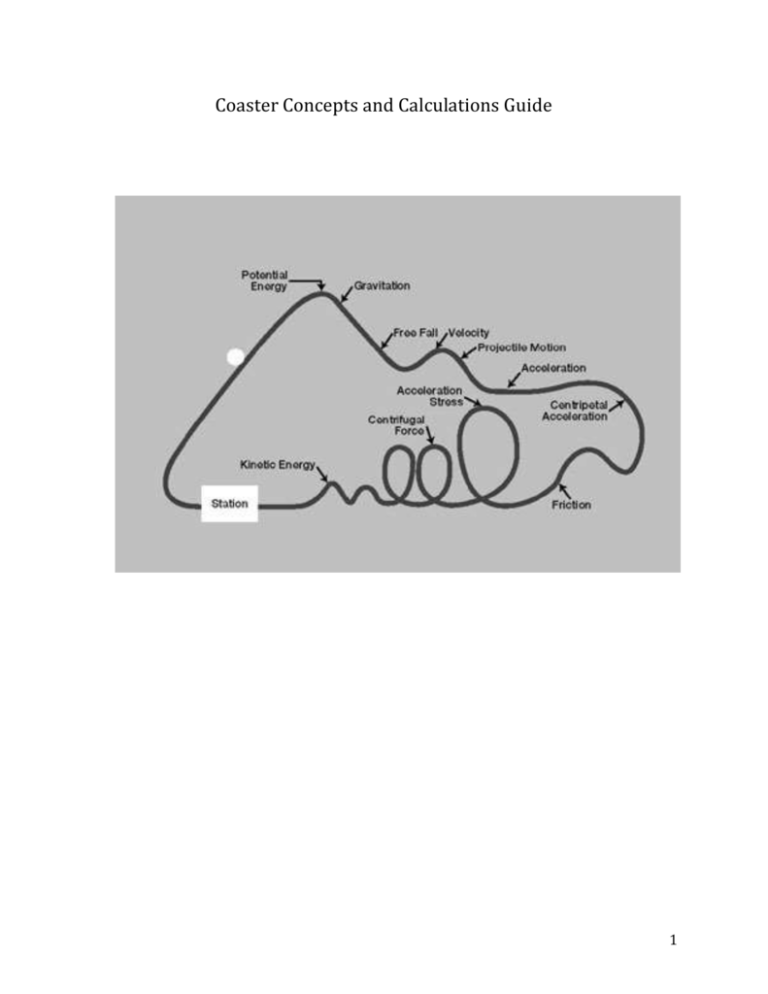
Coaster Concepts and Calculations Guide 1 Getting the Coaster Started (Work, Kinetic Energy, Potential Energy) Something has to be done to get the coaster started. Since we don’t have time to build an engine we can either catapult our marble forward or we can simply give it a push by hand and then use gravity to accelerate our coaster. Either way, something is going to do “work” on our marble. In physics the word work has a special meaning. Work is done whenever a force is exerted over a distance. You can calculate how much work is done by multiplying the force times the displacement. Displacement is a fancy word for “distance moved”. You’ve probably heard the word displace before. It comes up in two spots in the 8th grade curriculum. We mention it when we use the displacement method to find the volume of oddly shaped objects or substances like our sand. The water is displaced by the sand (it moves out of the way). It also comes up in World Cultures sometimes when you talk about displaced peoples (usually refugees) who also have been moved (usually by war or a natural disaster). Work = (Force)(Displacement) W = Fd Where “work” is measured in joules, J. “Force” is measured in Newtons, N, &“displacement” is measured in meters Example What is the velocity of the marble after being pushed into motion? Solution: Use the Total Energy equation and the Kinetic Energy equations shown below: KE = kinetic energy PE = potential energy m= mass v=velocity h= height g= 9.8 m/s 2 W= Fd Total Energy in = Total Energy out ; KE = ½ mv2 PE = mgh KE(at start) + PE(at start) +W(at start) = KE(at end) +PE(at end) (1/2)mv2 + mgh + Fd = (1/2)mv2 + mgh (1/2)3000(0)2 + 3000(9.8)(0) + 8800(12.5)= (1/2)3000v2 + 3000(9.8)(0) Substitute the numbers at each location 110,000 = (1/2)(3000)v2 73.333 = v2 v = 8.56 m/s ... at the end of the catapult. 2 In the previous example the force applied is known. How will you know the force used to push your marble into motion? The best method will be to use a drop chute door. I will demonstrate how to construct one of these in class. You can then be sure your initial force is only due to gravity and nothing else. Example 2 : Stopping your coaster. A roller coaster train of mass 3.0 X 103 kg rolls over a 11.5 m high hill at 8.34 m/s before rolling down into the station. Once in the station, brakes are applied to the train to slow it down to 1.00 m/s in 5.44 m. You can simulate brakes on your coaster using an increase in the friction force (you will have to figure out what materials will do this for your coaster). (a) What braking force (friction force) was need to slow the train down? (b) What was the acceleration of the train in g’s? Solution: (a) KE + PE = KE +PE +W (1/2)mv2 + mgh = (1/2)mv2 + mgh + Fd (1/2)3000(8.34)2 + 3000(9.8)(11.5) = (1/2)3000(1)2 + 3000(9.8)(0) + F(5.44) Substitute the numbersat each location 442433.400 = 1500 + 5.44F F = 81053.9 N ...force to slow down the train (b) Calculate the acceleration in m/s2. Then convert it into g’s. (g’s are discussed in the next section). F= ma 81053.934 N = (3000 kg)a a = 37.018 m/s2 a = 37.018 m/s2/ 9.80 m/s2 = 3.78 g’s ... Yeow! That’s a big jerk on the passengers into the restraining harness. G-forces are important. Read the next section to see what they are, how to calculate them and what G’s do to the human body. 3 Creating G FORCES! G forces are the reason to ride a roller coaster. There are three types: Positive G's: When riding a roller coaster, riders will sometimes feel very heavy in their seats. This feeling is caused by positive G's. Positive G's occur at the bottom of most hills and depend on how fast the coaster levels off. One G is the pull of normal gravity. Currently, we are all at one G, we experience this as our own weight. But if we're on a roller coaster, we can experience up to five G's (that feels like your own weight has grown five times!) When the coaster train levels off, riders are still moving down. This is when positive G's escalate. For example, let's say that there is a boy that ways 100 pounds. That is his weight at one G. At two G's the boy will feel like he ways 200 pounds. At three G's he will feel like he weighs 300 pounds. This continues as the G's increase. Most roller coasters pull about 4 G's. Some coasters pull five G's or even six. Once a person is at five G's, he/she is likely to black out because the heart has to pump five times as hard to get the “heavier” blood to the brain. At nine G's a person could die from lack of oxygen reaching the brain. Nothing pulls more than five G's except for fighter jets. Pilots can pull up to nine G's only because they have a G suit which will keep the blood flowing through out their bodies. Negative G's Negative G forces are the opposite of positive G's. These occur when cresting a hill on a roller coaster. Anything below one G is considered a negative G. At zero G's a person experiences a feeling of weightlessness. This occurs because on the uphill, you are still going up, while the train is trying to go down. This creates the common 'butt out off seat' experience. Roller coaster enthusiasts call it “air time”. Essentially, negative G's are a resistance of a force of gravity, since your moving upwards, not down. Negative G's don't end at zero G's. They continue going up with -1, -2 and upwards. As the numbers get lower, (i.e. larger number with a negative in front of it) the more force is acting upon you. The sensation you feel is that you are getting sucked out of the roller coaster train. You are kept in, though, by the restraints and the force of gravity which is usually strong enough to hold you in the car without the restraints. In my opinion, negative G forces are the best because of the “air time”. That's what a roller coaster is all about. However, too much negative G’s can cause a redout. This is the opposite of a black out. Your heart is able to pump blood so efficiently that you actually flood the brain with too much of it. This is only dangerous if it goes on for a long time or if you have an undiagnosed blood clot. Under extreme negative G’s such a clot may be able to break loose and cause a stroke (blockage of blood to the brain). A healthy person shouldn’t need to worry about this but sometimes we don’t know we have these conditions until something bad happens. So there is always a risk when you get on a coaster. However, for most healthy people the risk is very small. 4 Lateral G's A lateral G is the force that pushes the riders to the side. Lateral G's occur when the roller coaster is making a sharp turn left or rigth. Your body is going straight, but the coaster is turning. Banking the turn (tilting it) helps reduce some lateral Gs. Most of the coasters today have seat dividers which reduce lateral G's. In fact, some coasters have special seats that reduce the lateral G's. Older coasters didn't have seat dividers, which allow riders to slide across the seat and into their riding partner. If your riding partner is big like me you could get smushed! I call that the Stracuzzi G force. Weightlessness Weight is the pull of gravity on your mass. Typical weight units are pounds and Newtons. (1 pound is around 4.45 Newtons). On the moon, gravity pulls with 1/6 th the force compared to the Earth. Therefore, a student on the moon weighs 1/6 of what she weighs on the Earth. On the Earth, neglecting air resistance, all objects will speed up at a rate of 9.80 m/s every second they fall. That is a speed increase of about 22 mph for every second an object falls. Time in the Velocity Air (s) (mph) 0 0 1 22 2 44 3 66 4 88 5 110 There are two ways to experience weightlessness. (1) move far enough away from the planets and sun to where their pull is nearly zero. [Gravity acts over infinite distance. One can never completely escape it.] (2) Fall down at a rate equal to the pull of gravity. In other words, accelerate to the Earth speeding up 22 mph every second in the air. In order for a person to feel weight, a person must sense the reaction force of the ground pushing in the opposite direction of gravity. 5 In the absence of the reaction force a person will sink through the ground. Many amusement park rides generate the weightless sensation by accelerating down at 22 mph every second. g’s Neglecting air resistance, if a rock is dropped, it will accelerate down at 9.8 m/s2. This means it will speed up by 9.8 m/s for every second it falls. If a rock you drop accelerates down at 9.8 m/s2, scientists say the rock is in a “1 g” environment, [1 g = 9.8 m/s2 = 22 mph/s]. Any time an object experiences the pull equal to the force of gravity, it is said to be in a “one g” environment. We live in a 1 g environment. If a rock whose weight on the Earth is 100 lbs was moved to a 2 g environment then it would weigh 200 lbs. In a 9 g environment it would weigh 900 lbs. In a “NEGATIVE 2 g” environment it would take 200 lbs to hold the rock down on the ground. In a “-5 g” environment it would take 500 lbs to hold the rock down to the ground. If the rock were put into a “zero g” environment then it would be weightless. However, no matter what happens to its weight the rock’s mass would never change. Mass measurement is unaffected by the pull of gravity. What does it feel like to walk in a 2 g environment? Find someone who’s mass is about equal to yours. Have them give you a piggyback ride. As you walk around this is what it feels like to be in a 2 g environment. Go outside on the soft ground and step up on something squishy. This is when you will really know what a 2 g environment feels like. Often engineers will use g’s as a “force factor” unit. The force factor gives a person a way of comparing what forces feel like. All acceleration can be converted to g’s by dividing the answer, in m/s2, by 9.8 m/s2. 6 Example A roller coaster is propelled horizontally by a motor. The mass of the coaster train is 8152 kg. The train starts from rest and reaches a velocity of 26.1 m/s, 55 mph, in 3.00 seconds. The train experiences a constant acceleration. What is the coaster train’s acceleration in g’s? Solution m = 8152 kg vo = 0 (starts from rest) vf = 26.1 m/s t = 3.00 s a=? vf = vo + at 26.1 = 0 + a(3.00) a = 8.70 m/s in g’s... 8.70 m/s2 / 9.80 m/s2 = 0.89 g’s This means the rider is being pushed back into his seat by 89% of his weight. Physiological Effects of Acceleration Imagine a passenger riding through a loop on a roller coaster. The passenger’s head is towards the inside of the circle. Her feet are to the outside of the circle. In order to keep blood in the passenger’s head, a centripetal force needs to be applied to the blood to push it upwards toward the head and the center of the circle. The heart applies the centripetal force on the blood. A passenger can experience many g’s in a loop. Recall that a g is the number of times heavier an object becomes. A 7 g experience means that the passenger feels 7 times heavier. Everything about the passenger becomes 7 times heavier. Her 3 pound brain now weighs 21 pounds. Every ounce of blood becomes 7 times heavier. If the blood feels too heavy the heart cannot apply enough force to push it towards the head. If the brain does not get any blood it will not get the oxygen the blood carries. The passenger will pass out within a second. 7 THE EXTREME EXPERIENCE You are riding a new untested roller coaster when something goes wrong. As you enter the first big loop, a great pressure pushes you down. You slouch down in the seat from the extra weight. Over the top of the loop the roller coaster car slows down. The extra weight on your legs, lap, and shoulder make it impossible to sense that you are upside down. Out of the loop, over a hill and into another loop. This loop has a smaller radius. The car is traveling much faster now. As the g forces climb up toward 7 g’s, you sink further still in the seat. You can no longer see color. Everything appears in black and white. An instant later, the passenger next to you disappears from view. Your field of vision is shrinking. It now looks like you are seeing things through a pipe. The front corner of the car disappears from view as your peripheral vision disappears. The visual pipe’s diameter is getting smaller and smaller. You sink into the seat further still as the number of g’s climb further. In a flash you see black. You have just “blacked out.” You are unconscious until the number of g’s are reduced and the blood returns to your brain. Amusement park owners and insurance companies don’t want the previously described situation to occur. It would limit repeat riders and the number of potential consumers who can safely ride the coaster. Most roller coasters keep the g’s felt under 5 g’s on an inside loop or the bottom of a dip after a hill. When a rider travels over a hill at a high rate of speed, he experiences negative g’s. A negative g is the multiple of a person’s weight that is needed to keep a rider in his seat. Negative g’s also force the coaster car to try to come up off the track. Negative g’s are a rider’s heaven and a designer’s nightmare. Negative g’s are avoided as much as possible. A negative g has a different effect on a rider than a positive g. Both negative and positive g’s can cause a rider to pass out. But negative g’s cause a rider to “red out.” A red out condition occurs when there is too much pressure on the brain caused by too much blood in the head. The extra pressure can cause blood vessels to burst and kill the rider. This is a sure way to limit the number of repeat riders. There is another way for a rider to experience negative g’s. It is related to the length of the train. The roller coaster track is designed for the rider at the center of mass of the coaster train. Negative g’s are experienced by the rider at the back of the train as he travels over a hill. For an empty train, the center of mass is in the middle of the train. Whatever speed is acquired by the center of the train is the speed for the entire train. After the center of a train passes over a hill it begins to gain velocity. As the center speeds up so does the back of the train. This means that the rear of the train will travel over the hill faster than the middle of the train. If the rider travels over the hill faster than the designed velocity of 8 the hill the rear car will be whipped over the hill. We don’t have to worry about this for our coaster because we have only one “car”; the marble. G forces in loops: 9 CALCULATION OF THE G’S FELT in a loop: Use this circular motion formula: Where “v” is the velocity of the marble and “R” is the radius of the circle traveled. To calculate the velocity use the energy formula (KE + PE = KE + PE). One more thing: to calculate the g’s felt remember that the g’s felt by the rider is the normal force on the seat of the rider divided by the mass then converted into g’s. As a rider enters a loop he will feel 2 forces. The real number of interest is the number of g’s felt by the passenger traveling in the vertical circle. The g’s felt are affected by whether or not you are above or below the horizontal line. While above it the normal force is above you pushing down and while below it the normal force is beneath you pushing up. 10 Regular, Circlular Loop Example: SOLUTION To calculate the g’s at the top of the loop, you will need to know the velocity of the rider there. To find velocity, use the total energy formula. Energy at the top has to equal energy at the bottom. KE (at top)+ PE(at top) = KE(at bottom) + PE(at bottom) KE = ½ mv2 PE= mgh ½ mv2 + mgh = ½ mv2 + 0 Notice how we have m (mass) on both sides of the equation. Neat math trick…you can take it out since it cancels itself out. So the new equation is: ½ v2 + gh = ½ v2 There are two velocities in the above equation. The first one is the velocity of the coaster at the top and the second one is the velocity of the coaster at the bottom. We know the velocity at the bottom so put it in (30) and solve for the other one (velocity at the top). ½ v2 + 9.8(17) = ½ (30)2 = 23 m/s at the top. Now let’s find the acceleration and g forces: acentripetal = v2/9.8 = (23)2/9.8 = 56 m/s2 G’s = 56/9.8 = 5.7 g’s but G’s felt = 5.7 g’s – 1 g (because we are on the top of the loop) = 4.7 The rider will not pass out because 4.7 is less than 8 g’s. The irregular loop example: The circular loop is easy enough to calculate. The irregular shaped loop needs a little more work. The velocity as the car enters the loop should be known. First establish the g’s that you want the rider to feel at the bottom. Subtract one g for what the track exerts. Then convert these g’s back to acceleration (just multiply your g force by 9.8) 11 EXAMPLE STEP 1 (I’m randomly choosing 6 g’s as the limit for the rider) Therefore the centripetal acceleration of the track is 6g - 1g = 5g’s because we are above the horizon. STEP 2 (convert these g’s to m/s2) STEP 3 Now to calculate what the rider feels at the top of the loop. Decide on the height of the loop. Then decide how many g’s the rider will experience. Use the loop formula with centripetal acceleration to calculate the radius. STEP 4 The top of the loop will be at 25 m. (Chosen pretty much at random.) STEP 5 I’m randomly choosing 6 g’s again as the limit for the rider. It could be almost any number. At the top of the loop add 1 g for the centripetal force. (“Add” because the rider is upside down, above the horizon.) 6g’s + 1 g = 7g 12 STEP 6 convert g’ to m/s2 STEP 7 (1/2)(m)(35)2 = (1/2)(m)vo2 +(m)(9.80 m/s2)(20 m) The m’s divide out. (1/2)(35)2 = (1/2)vo2 +(9.80 m/s2)(20 m) vo = 28.86 m/s STEP 8 Calculate the radius at the top In reality, a person will not pass out the instant he/she reaches 8 g’s. It will take a few seconds of being at 8 g’s for the person to pass out. But for the sake of easy calculations we will assume that the instant 8 g’s is reached a person will pass out. 8 g’s is an average. people generally pass out between 6 to 10 g’s. (FYI: The 40 g mark mentioned earlier is instantaneous for death.) 13 HORIZONTAL CURVES AND TURNS A horizontal curve is a curve that does not rise or fall. There are two types of curves, flat curves and banked curves. FLAT CURVES A flat curve gives a rider the sensation of being thrown sideways. If the roller coaster car’s velocity is fast enough and the radius small enough, the stresses on the cars’ under carriage can be tremendous. For a flat curve the acceleration felt by the rider is calculated from the equation. Where “a” is the acceleration felt by the rider to the inside of the circle, “v” is the velocity of the car and “R” is the radius of the curve. This acceleration can be converted to g’s by dividing it by 9.80 m/s2. Example 1 A car travels around a flat curve at 20 m/s. If the curve has a radius of 13.61, then how many g's does the rider feel? Solution 14 BANKED CURVES A banked curve reduces the rider’s sensation of being thrown sideways by turning the car sideways. The car is tilted. The trick is to tilt the track just the right amount. The ideal banked curve is one where no outside forces are needed to keep the car on the track. In other words, if the banked curve were covered with ice -no friction- and the coaster did not have a steering mechanism the car would stay on the track. This is the ideal banked curve. These are the forces acting on the car as the car travels around horizontal banked curves. This is for the ideal banked curve where no friction is required to keep the car from sliding to the outside or inside of the curve. R is the curves radius; v is the car's velocity; g is the acceleration due to gravity, and the angle is the angle with the horizontal as shown in the diagram. On a given curve if the velocity is greater or less than the design velocity then the cars may need a little frictional help to keep them on the track. Here are some equations you can use to calculate an ideal banking of your curve (the angle of banking is shown with the Greek letter theta shown above as an oval with a line through it. 15 Calculating g’s Felt on a Banked Curve Whoa Nelly! You do not have to do these calculations. They use a mathematical technique known as trigonometry and you won’t learn trigonometry till you are a sophomore or a junior in high school. However, you should realize that the rider will feel a combination of the forces pulling down due to gravity and the also pushing sideways as the track propels the rider to the center of the circle. Combining these two forces is tricky so we will just have to assume that if you used the equation above to find the right angle your G’s will stay under the required amount. 16 Hills and Dips (Projectile Motion, Potential Energy and Kinetic Energy) One of the most basic parts of a ride is going from the top of a hill to the bottom. There are two basics ways designs for transporting riders to the bottom of a hill. The first is called the “Speed Run.” SPEED RUN DROPS A speed run is designed to give the rider the feeling of accelerating faster and faster without the feeling of weightlessness. It simulates being in a powerful car with the accelerator held down to the floor. It is a straight piece of track that connects a high point to a low point. The increase in velocity of the car comes from lost gravitational potential energy being converted into kinetic energy. Next to a horizontal straight piece, the speed run is the easiest piece of the track to design and analyze. When coasting up to a new height the calculations are the same as the example shown above. The shape of the hill does not matter. See the “Step by step guide” section, step 7, for an example of these up hill calculations. 17 FREE FALL DROPS One of the biggest thrills on a roller coaster is the free fall as a rider travels over a hill. The easiest way to experience free fall is to hang from a tall height and drop to the ground. As a person falls he experiences weightlessness. As long as a person travels in the air like a projectile he will feel weightless. Suppose a ball traveled off a table, horizontally, at 10 m/s. The ball’s path would look like the path shown below. Now suppose the ball traveled off the table top on a shallow angled ramp. It would look like the one below. A straight, “speed run,” drop does not match the fall of a rider over a hill. 18 To give riding more of a thrill, the designer needs to design the shape of the hill to match the falling ball. The only problem with curve above is the impact with the floor. To alleviate this problem another curve scoops the balls as they descend. This makes the ride smooth and survivable for the rider. The speed at the bottom of a free fall drop is calculated the same way as the speed at the bottom of a speed run drop. The only difference is the shape of the hill from the top to the bottom. 19 PROJECTILE MOTION AND ROLLER COASTER HILLS A free fall hill shape gives a rider a weightless sensation. To give this weightless sensation over a hill, the hill is designed to have the same shape as the path of a ball being thrown off the top of a hill. Shape is determined by how fast the roller coaster car travels over the hill. The faster the coaster travels over the hill the wider the hill must be. Apply projectile motion concepts to design the hill’s shape. Calculate your coaster’s position as if it had flown off a cliff. The position equation is as follows. This can be rewritten as EXAMPLE CALCULATIONS x in meters from hill's center h in meters from the hill's top 0.00 0 4.52 1 6.39 2 7.82 3 9.04 4 10.10 5 11.07 6 11.95 7 12.78 8 13.55 9 14.29 10 There comes a certain point on the free-fall drop where the track needs to redirect the riders. Otherwise the riders will just plummet into the ground. This point is the transition point from free-fall to controlled acceleration. This point is also the maximum angle of a hill. To figure out the best angle for your catch hill you can use trial and error. Calculate the force on your rider at the most critical point of your catch curve (right at the point where the hill direction begins to change). This will tell you whether or not your rider is experiencing acceptable Gforces. 20 Loops (Circular Motion, Potential Energy and Kinetic Energy) CENTRIPETAL FORCE The average person on the street has heard of centrifugal force. When asked, they would describe this force as the one pushing an object to the outside of a circle. There is only one problem with this description. There is NO FORCE pushing an object to the outside. For a person riding in a car while traveling in a circle, he feels a force pushing him to the outside of the circle. But what force is physically pushing him? It cannot be friction. Frictional forces oppose the direction of motion. It can’t be a “normal force1 .” There is not a surface pushing the rider to the outside. To travel in a circle, a force pointing to the inside of the circle, or curve, is needed. The force pointing to the inside is called the centripetal force. To understand a source for the misconception of the direction of this force, consider what it feels like when traveling around a corner in the back seat of a car. Everyone who has been in this situation knows that the passenger will slide to the outside of the curve. To understand that there is no force pushing the passenger to the outside, a change of reference frame is needed. Move the point of view from inside the car to a location outside, above, the car. A COASTER’S LOOP On a well designed roller coaster loop, the riders will not be able to sense when they are traveling upside down. This is done by making sure the force that is exerted on the rider is at least equal to the weight of the rider. 21 Centripetal force applied to the track depends on the velocity of the car and inversely to the radius. The formula is: In order to apply enough centripetal acceleration the roller coaster car has to either be traveling very fast or the radius of the loop has to be made small. Most rides have a tall loop. A tall loop means a big radius. The problem is, as a car goes up, it slows down. The higher it goes, the slower it will be traveling over the top. In order to apply a centripetal force equal to gravity, 1 g, at the top, the car must be traveling extremely fast as the rider enters the loop. On some of the early round loops, the riders actually had their necks broken as a combination of the sudden rise in the loop as they entered at an extremely high rate of speed. As a compromise, the loops today are designed around an irregular shape called a klothoid or spiral of Archimedes. These irregular loops allow a circular figure whose radius changes. Clothoid Loops (in English we like to use the letter C instead of K. K is the Greek version) Roller coasters today use clothoid loops rather than the circular loops of earlier roller coasters. This is because circular loops require greater entry speeds to complete the loop. The greater entry speeds subject passengers to greater centripetal acceleration through the lower half of the loop, therefore creating 22 greater G’s. If the radius is reduced at the top of the loop, the centripetal acceleration is increased enough to keep the passengers and the train from slowing too much as they move through the loop. A large radius is kept through the bottom half of the loop, thereby reducing the centripetal acceleration and the G’s acting on the passengers. 23
